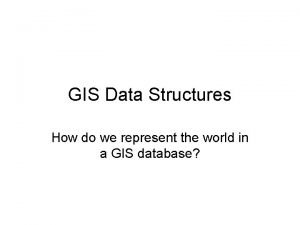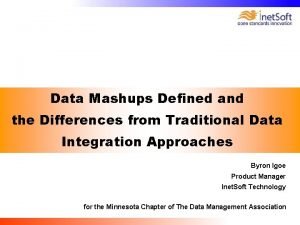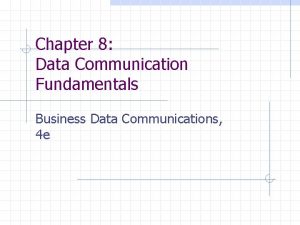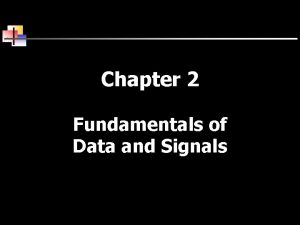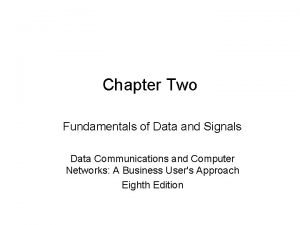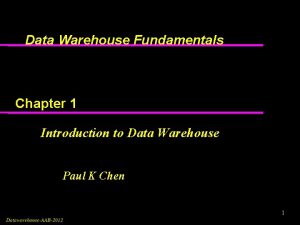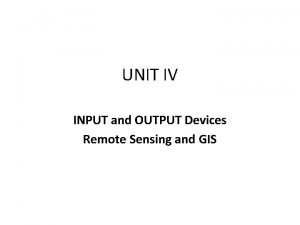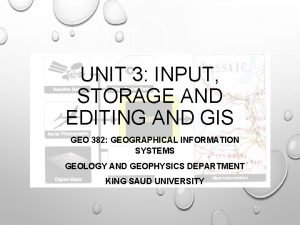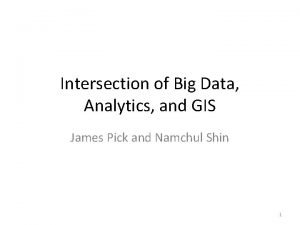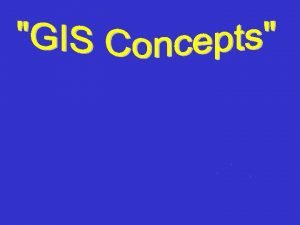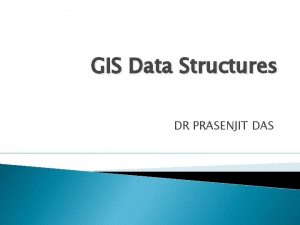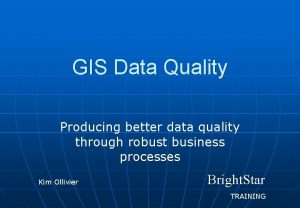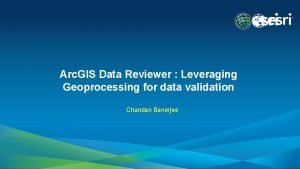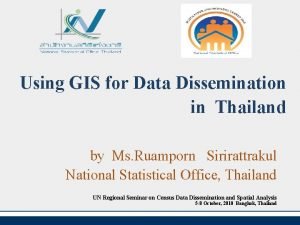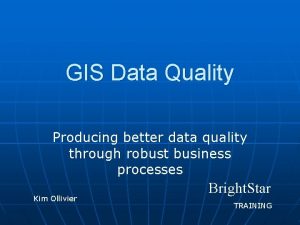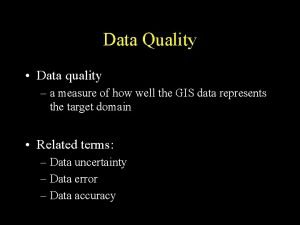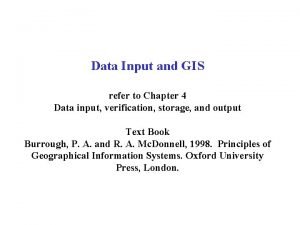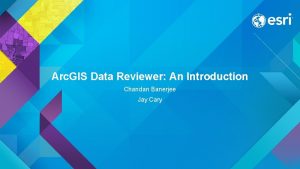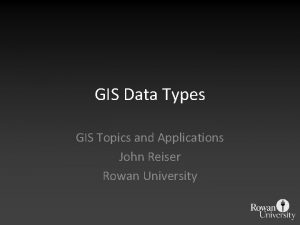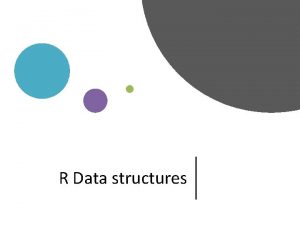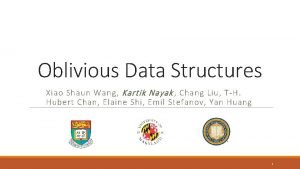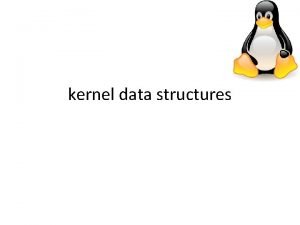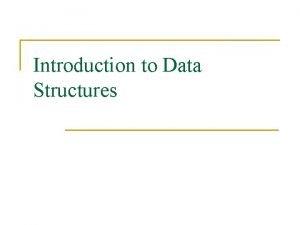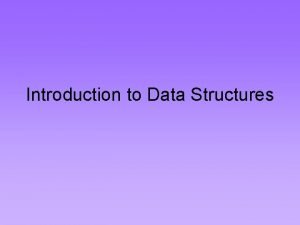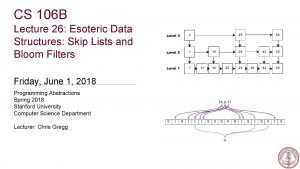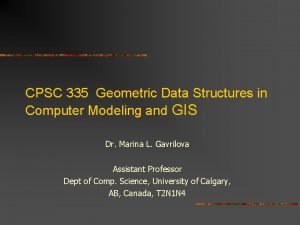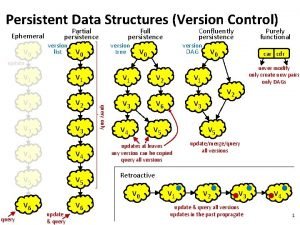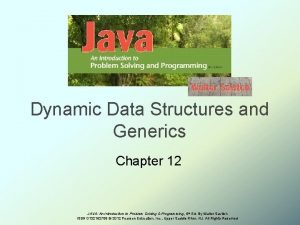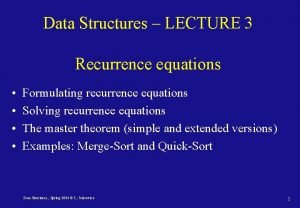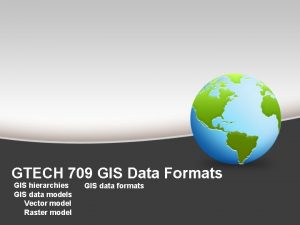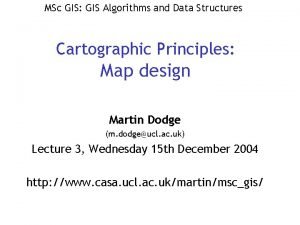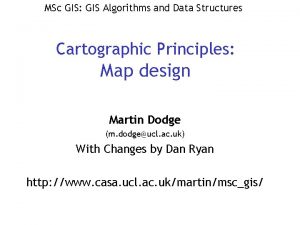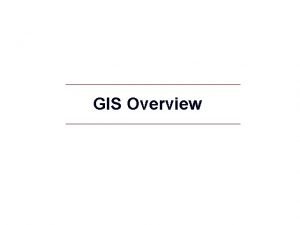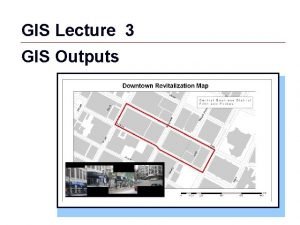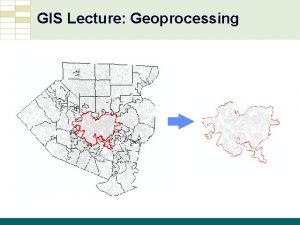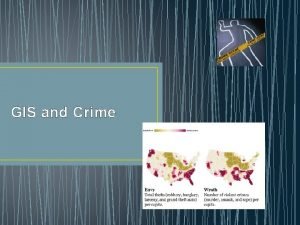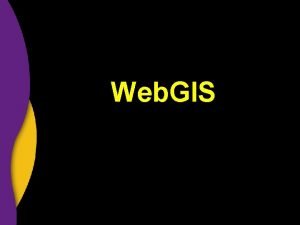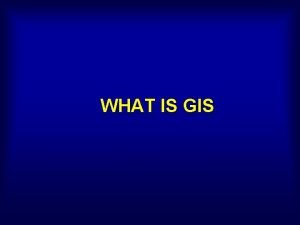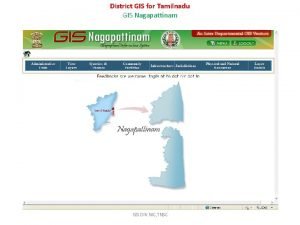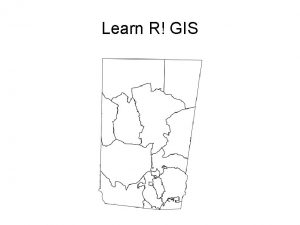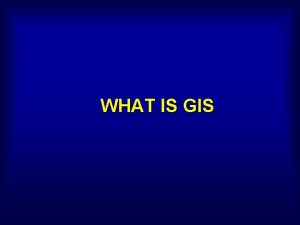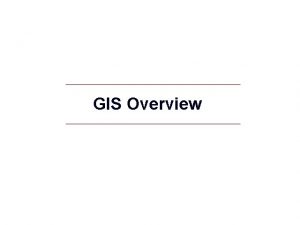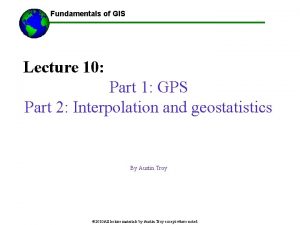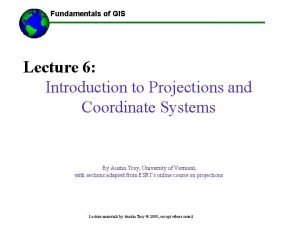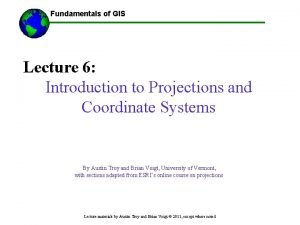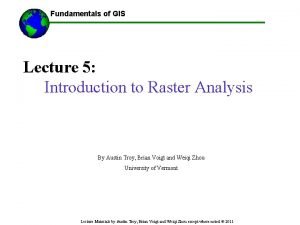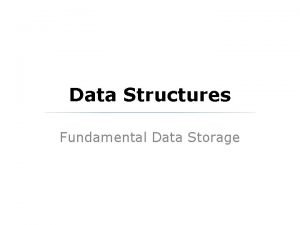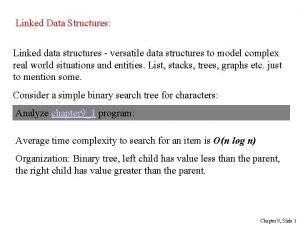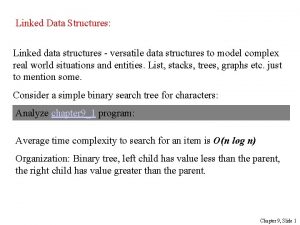Learning GIS Fundamentals II GIS Data Structures Data


















































- Slides: 50

Learning GIS Fundamentals II: GIS Data Structures & Data Sources

What is GIS Data? • Digital, geographically referenced data – GIS data, spatial data, geospatial data. • Is a printed map GIS Data? • Is a printed map geographic data?

GIS Data Structures • Vector Model • Raster Model

Vector Graphics • Vector graphics to represent discrete features on or below the surface of the Earth. Points Hospital, crime/disease incident, manhole, well, parking meter, city, etc. Lines Road, river, sewer, etc. Polygons Administrative district, building, parcel, lake, river, etc.

Geographic Information Systems • Information n Geo-Graphics attached to a database Road from Mass. GIS

GIS Data Formats - Vector • ESRI formats § Shapefile § Coverage • Topology, multiple geometries • Come bundled as E 00 files • Always use Arc. Catalog to move and delete coverages § Geodatabase • Object-oriented GIS • Many other formats § § Map. Info DLG TIGER VPF See example of Shapefiles on your computer

Raster Graphics Represent continuous surfaces Composed of a grid of pixels Resolution is the measure of the smallest object that can be resolved by the sensor or the dimension on the ground represented by each pixel (i. e. , 30 meters) Pixel = 0. 8 feet 2003 Boston digital orthophoto (aerial photograph)

Raster Data • Land Cover n Grid of land cover classifications Cell/Resolution = 1 km, Value = land cover code 2001 Africa Land Cover

Raster Data • NDVI – Vegetation Indices n Measure of vegetation brightness derived from satellite imagery. Often used for change detection

Raster Data • Digital Elevation Model (DEM) n Grid of elevation values Mass. GIS DEM Cell/Resolution = 5 meters, Value = elevation

GIS Data Formats - Raster • ESRI formats § ESRI Grid • Always use Arc. Catalog to move or delete Grids • Many other formats § § § TIFF (. tif) Geo. TIFF Mr. SID (. sid) JPEG (. jpg) JPEG 2000 (. jp 2) DEM

Scale • Scale of GIS data is denoted as a representative fraction 1: 24, 000 = 1/24, 000 n One inch on the map equals 24, 000 inches on the ground n Usually the smaller the number in the denominator, the more accurate the dataset is, or the larger the scale the dataset is § 1: 24, 000 is larger scale than 1: 250, 000 § Urban scale: 1: 1200, building footprints, property boundaries, etc. n • All GIS data is derived at a certain scale, which generally corresponds to the level of horizontal accuracy

Scale

Map Projections • A map projection is a means of translating the curvaceous three-dimensional surface into a flat twodimensional representation • All GIS data has an inherent map projection

Map Projections • A map projection means of translating the curvaceous three-dimensional surface into a flat two-dimensional representation • All GIS data has an inherent map projection

Coordinate Systems/Datums • Coordinate systems/datums are the referencing framework so that positions can be measured and estimated – Model of the planet – Origin points • Can be local or global – WGS 84: Global – NAD 83: Local • GIS data has an inherent coordinate system/datum • The combination of the map projection and the coordinate system/datum allows disparate datasets to be brought together

GIS Data Structure/Quality Summary • Either raster or vector model • Comes in a particular format: – Shapefile, coverage, geodatabase, grid, TIFF, etc. • Derived at a particular scale which relates to the horizontal accuracy of the data. – 1: 1, 000; 1: 250, 000; 1: 50, 000; etc. • Inherent map projection & coordinate system – Geographic coordinate system (GCS) or unprojected, UTM, State Plane, etc. • Represents a particular date in time (i. e. , 2000) • Has a source. Someone made this data.

GIS Features or Data Layers So what GIS data layers (geographic features) might be useful for human and animal health and wildlife conservation?

Sources of GIS Data • National, state, and local agencies • International organizations & NGOs • Map & government document libraries § Harvard Map Collection and Harvard Government Document Library • Commercial agencies § East. View Cartographic, etc. • Wide variety of international data and maps • http: //gis. tufts. edu

Steps to finding data? • Internet § Spatial data portals & clearinghouses • http: //gis. tufts. edu § Google it • Afghanistan rivers. shp • GIS Center networked data: M: • GIS Center CDs/DVDs

GIS Center World Wide Datasets • ESRI Data & Maps – Base data around 1: 5, 000 • Global GIS DVD – Base data around 1: 1, 000 – Particularly for its gazetteer data – Based largely on Digital Chart of the World (DCW) • “Improved” • FAO Land & Water Series

World Wide Datasets • Digital Chart of the World (DCW), VMAP 0 – National Geo-spatial Intelligence Agency (NGA) • Formerly NIMA, DOD – Scale: 1, 000 – Geographic base mapping of the world – Sources • Harvard Geospatial Library (http: //hgl. harvard. edu) – By selection area • Penn State – By country • On CD by tiles • Many other sources – NGA, Commercial vendors, etc.

World Wide Datasets • VMAP 1 § § § NGA World-wide dataset at 1: 250, 000 Only about 30% of world is released Nickname: VCrap Sources • Online from a variety • Must convert from VPF format

Data at a Scale Larger than 1: 250, 000 • National Mapping Agencies § Index of National Mapping Agencies • National Statistical Bureaus § Index of National Statistical Bureaus • Foreign Copyright § Map Sources § Harvard Map Collection § Boston Public Library § Commercial Vendors • Foreign Statistics § Harvard Government Documents Library

U. S Data • National Agencies – USGS, Census Bureau, EPA, CDC, NIH – Scale: 1: 100, 000 to 1: 24, 000 • State Agencies – Mass. GIS, Vermont GIS – Scale 1: 24, 000 to 1: 5, 000 • County & Municipal Agencies – City of Cambridge, Boston, San Diego County, etc. • GIS Dept, Planning, Engineering, Assessing, etc. – Scale 1: 5, 000 to 1: 1200

Metadata Describes geospatial data and attribute data • Creator of the data • Time period does it represent • Scale or resolution is the data • Map projection • Coordinate system • Linear units • Attribute values and field names

What if GIS Data, digital geographically referenced files, don’t exist? One must develop GIS data? • • Hard copy maps Remotely sensed imagery Global Positioning System (GPS) Need to be converted, interpreted or captured to be used within GIS

Hard Copy Maps Crucial source of geographic information for GIS • International data at larger scales • 1: 250 k, 1: 50 k, etc. • Historical data

Hard Copy Maps: Conversion Process • Scan map • Georeference digital map image – Assign geographic coordinates to the map image • Trace and encode the features off the map • Accra Example – Is this map GIS data?

Remotely Sensed Imagery • Measurement or acquisition of information about the environment by aircraft, spacecraft, or satellite

Remotely Sensed Imagery • Composed of a grid of pixels • Resolution is the measure of the smallest object that can be resolved by the sensor or the dimension on the ground represented by each pixel (i. e. , 30 meters) Pixel = 0. 5 meters 2005 Mass. GIS digital orthophoto

Remotely Sensed Imagery • Remote sensor measures electromagnetic radiation (EMR) reflected or emitted from an object. • Objects reflect EMR differently

Remotely Sensed Imagery • Remote sensor measures electromagnetic radiation (EMR) reflected or emitted from an object. • Objects reflect EMR differently Landcover classification

Remotely Sensed Imagery

Remotely Sensed Imagery • Acquisition: specific region at specific time period • Obscured by: § Cloud cover § Smoke § Tree Cover

Aerial Photography 2003 Boston digital orthophoto (aerial photograph)

Satellite Imagery - Landsat • Resolution: 30 m , 15 m • Spectral Resolution: 7 bands • Use: regional Analysis, not for urban feature identification Northwestern Sumatra, Dec. 13, 2004 Northwestern Sumatra, Dec. 29, 2004; 3 days after Tsunami

Change Detection

Satellite Imagery – Quickbird & IKONOS Resolution 1 m – 60 cm Use: Feature Identification Quick. Bird 60 cm, Beirut

Field Methods: Global Positioning System (GPS) • A system of satellites & receiving devices used to compute positions on the Earth. • Record coordinates of locations of features such as surveys, health centers, schools, etc.

Global Positioning System (GPS) • Used to locate surveys, features, etc. • Accuracy – Handheld: 3 -10 m – Differential GPS: 3 m – 1 cm • Cost – Handheld: $150 - $400 – DGPS: $2, 500 and up • Issues – – – – Ruggedized unit Tree canopy, urban canyons, etc. Go wireless, cables can break and get in the way Bring extra batteries, car charger, etc. Link to your database with codes Use with Pocket PC for easier data collection Capture additional data while doing survey

Developing GIS Data Hard copy maps Remotely sensed imagery Global Positioning System (GPS)

Data Acquisition • Negotiate: free use or discounted use, let them advertise • Multi-user license: more $$ • Going local: small fee or “gift exchange” • Metadata: Get it! • Areas of conflict/dispute: restricted access § India borders, Israel, etc.

GIS Lab II: GIS Data Structures & Data Sources

GIS @ Tufts • gis. tufts. edu n http: //gis. tufts. edu

Mass GIS Data Lab • Browse the data layers and see what’s available • What data layers would be useful for your area of research? • Download selected layers of interest • DO NOT download – – Roads Orthophotography Elevation Land Use

Mass GIS Data • • • What is it? Is it raster or vector What time period does it represent? What is the source? What scale is the data? What is the coordinate system/projection?

What Data Do We Need? • What geographic features do we need? – Administrative boundaries, hydrography, roads, land cover, etc? • What geographic extent? What geographic area? – World, continent, country, region of country, city, neighborhood, etc. ?

Steps to finding data? • Internet § Spatial data portals & clearinghouses • http: //gis. tufts. edu § Google it • Afghanistan rivers. shp • GIS Center networked data: M: • GIS Center CDs/DVDs

Questions? Comments? http: //gis. tufts. edu Patrick Florance Senior GIS Specialist, UIT Tufts University
 Fundamentals of data structures in c
Fundamentals of data structures in c Fundamentals of python data structures
Fundamentals of python data structures What is data structure in gis
What is data structure in gis Homologous structures example
Homologous structures example Cuadro comparativo de e-learning
Cuadro comparativo de e-learning Data mashups and gis are data integration technologies.
Data mashups and gis are data integration technologies. Google earth
Google earth Self-taught learning: transfer learning from unlabeled data
Self-taught learning: transfer learning from unlabeled data Fundamentals of data communication
Fundamentals of data communication Fundamentals of data and signals
Fundamentals of data and signals Fundamentals of data and signals
Fundamentals of data and signals Frquency domain
Frquency domain Data warehouse fundamentals
Data warehouse fundamentals Fundamentals of data structure in c
Fundamentals of data structure in c Cardinality and modality in database
Cardinality and modality in database What is the inputting device for gis
What is the inputting device for gis Keyboard entry in gis
Keyboard entry in gis Big data and gis
Big data and gis Non spatial data
Non spatial data What is gis data structure
What is gis data structure What is data quality in gis
What is data quality in gis Gis data validation
Gis data validation Thailand gis data
Thailand gis data Data quality in gis
Data quality in gis Micro and macro components of accuracy
Micro and macro components of accuracy Data collection and input in gis
Data collection and input in gis Gis data validation
Gis data validation Polk county gis florida
Polk county gis florida Gis data types
Gis data types Attribute data query in gis
Attribute data query in gis Btech smart class.com
Btech smart class.com Types of data structures in r
Types of data structures in r Oblivious data structures
Oblivious data structures Linux kernel map data structure
Linux kernel map data structure Introduction to data structures
Introduction to data structures Introduction to data structures
Introduction to data structures Ajit diwan iit bombay
Ajit diwan iit bombay Esoteric data structures
Esoteric data structures Geometric data structures
Geometric data structures Kevin wayne princeton
Kevin wayne princeton Data structures and algorithms tutorial
Data structures and algorithms tutorial Hadoop i/o compression and serialization
Hadoop i/o compression and serialization Conditional macro expansion example
Conditional macro expansion example Advanced data structures in java
Advanced data structures in java Assembler data structures
Assembler data structures Debasis samanta data structure
Debasis samanta data structure Persistent vs ephemeral data structures
Persistent vs ephemeral data structures Php data structures
Php data structures Information retrieval data structures and algorithms
Information retrieval data structures and algorithms Dynamic data structure in java
Dynamic data structure in java Recurrence data structures
Recurrence data structures


